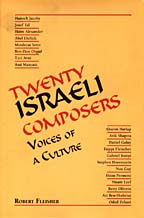Detroit: Wayne State University Press, 1997
380 p. $39.95
This Review was written by Marion Stein
It is reprinted from Notes: Quarterly Journal of the Music Library Association, vol. 55, no. 1 (September 1998) by permission of the Music Library Association.
ISBN: 0-8143-2648-X

In 1986, Robert Fleisher spent two months at the center for visiting artists and scholars known as Mishkenot Sha’ananim opposite the wall of Jerusalem’s old city. There he interviewed twenty-four Israeli composers, and in the present volume he brings us oral histories of twenty of these, based on the interviews. The topics covered include the composers’ reflections on their own individual creative output, the place of their music within Israeli music culture, and life in Israel and how it affects their work. The reader gets a good picture of how the special character of modern Israeli history helps to create the culture of the land, a culture born in a relatively young country set in an ancient land, with a population drawn from every conceivable place on earth but at the same time sharing the commonality of Jewish identity.
Fleisher, a professor of music theory and composition at Northern Illinois University, gives the reader an informative and engrossing look at the Israeli art music world. He has preserved each subject’s own verbal style in these first-person narratives, creating an immediacy not possible in an impersonal discussion. He also provides a brief introductory statement and a portrait photo of each composer to accompany the interview. Afterwards, he brings the reader up to date by telling what the composer has done in the intervening ten years.
The book is arranged by generation. The composers of the first generation, those born abroad before 1920, fall into a variety of categories. Josef Tal and Abel Ehrlich are described as avant-gardists. Haim Alexander is the only one to be influenced by jazz. Hanoch Jacoby is the conservative of the group, a pupil of Paul Hindemith who employs folk music and cantillation as thematic material. Mordechai Seter is a serial composer in the vein of Olivier Messiaen rather than Arnold Schoenberg.
The composers of the second generation acquaint the reader with their extended families. Ben-Zion Orgad speaks of his connections to Arik Shapira, a composer of the third generation. Tzvi Avni tells us that Ehrlich was his first theory teacher and that Seter was the one to awaken his interest in melody. Ami Maayanai tells of finding his inspiration in the traditional types of Jewish music and does not mention a specific teacher in Israel.
The twelve third-generation composers show a stronger level of influence from international styles and trends than their predecessors. They are not as nationalistic as their predecessors and seem more comfortable developing their own unique amalgam to create their styles. This group is more varied (and larger) than the earlier two. Among them we find “three women, seven sabras [native born Israelis] and immigrants from Eastern and Central Europe and North and South America” (p.167). Several of these count composers of the earlier generations among their teachers.
The immigrants are Aharon Harlap from Canada, Daniel Galay from Argentina, Gabriel Iranyi from Romania, Stephen Horenstein from the United States, and Haim Permont from the former Soviet Union. The three women–Noa Guy, Tsippi Fleischer and Betty Olivero–are all sabras. Yinam Leef, Arik Shapira, Oded Zehavi, and Ari Ben-Shabetai are also sabras.
Fleisher includes music examples to illustrate composers’ descriptions of their work. There are extensive, well-written, and highly informative notes for each chapter, a select discography and bibliography, and an index. Twenty Composrs is a readable book that complements the short list of books in English about Israeli art music, of which the most notable is Alice Tischler’s A Descriptive Bibliography of Art Music by Israeli Composers (Warren, Mich.: Harmonie Park Press, 1988).
This book is recommended for all academic music collections, Judaica collections, and those specializing in Israeli and regional history and sociology. Fleisher integrates music into the history and general culture of Israeli society and shows the reader how they inform one another. This is an original contribution to the subject.
